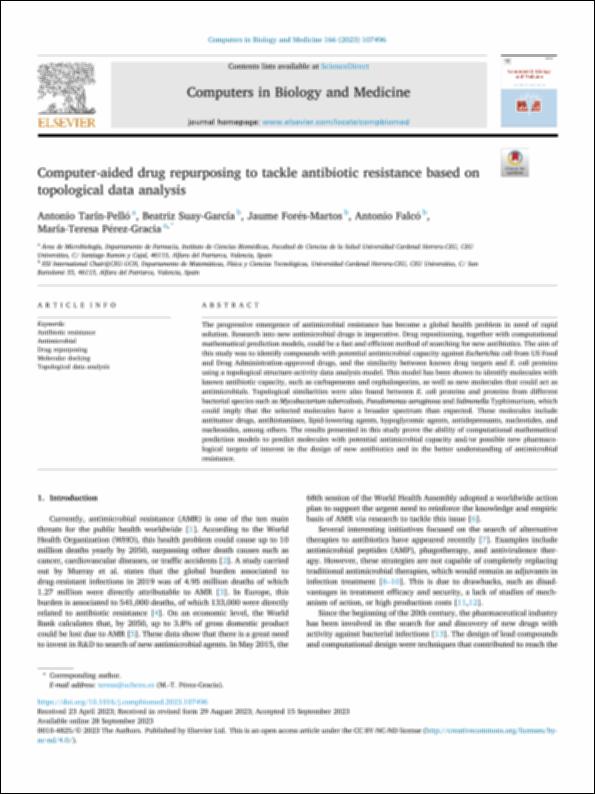Please use this identifier to cite or link to this item:
http://hdl.handle.net/10637/15898Computer-aided drug repurposing to tackle antibiotic resistance based on topological data analysis
| Title: | Computer-aided drug repurposing to tackle antibiotic resistance based on topological data analysis |
| Authors : | Tarín Pelló, Antonio Suay García, Beatriz Forés Martos, Jaume Falcó Montesinos, Antonio Pérez Gracia, María Teresa. |
| Keywords: | Medicamento; Drugs; Topología; Topology; Bacteria; Antibiotic resistance of bacteria; Resistencia a los antibióticos de las bacterias; Data analysis; Análisis de datos |
| Publisher: | Elsevier |
| Citation: | Tarín-Pelló, A., Suay-García, B., Forés-Martos, J., Falcó, A. & Pérez-Gracia, M.T. (2023). Computer-aided drug repurposing to tackle antibiotic resistance based on topological data analysis. Computers in Biology and Medicine, vol. 166 (nov.), art. 107496. DOI: https://doi.org/10.1016/j.compbiomed.2023.107496 |
| Abstract: | The progressive emergence of antimicrobial resistance has become a global health problem in need of rapid solution. Research into new antimicrobial drugs is imperative. Drug repositioning, together with computational mathematical prediction models, could be a fast and efficient method of searching for new antibiotics. The aim of this study was to identify compounds with potential antimicrobial capacity against Escherichia coli from US Food and Drug Administration-approved drugs, and the similarity between known drug targets and E. coli proteins using a topological structure-activity data analysis model. This model has been shown to identify molecules with known antibiotic capacity, such as carbapenems and cephalosporins, as well as new molecules that could act as antimicrobials. Topological similarities were also found between E. coli proteins and proteins from different bacterial species such as Mycobacterium tuberculosis, Pseudomonas aeruginosa and Salmonella Typhimurium, which could imply that the selected molecules have a broader spectrum than expected. These molecules include antitumor drugs, antihistamines, lipid-lowering agents, hypoglycemic agents, antidepressants, nucleotides, and nucleosides, among others. The results presented in this study prove the ability of computational mathematical prediction models to predict molecules with potential antimicrobial capacity and/or possible new pharmacological targets of interest in the design of new antibiotics and in the better understanding of antimicrobial resistance. |
| URI: | http://hdl.handle.net/10637/15898 |
| Rights : | http://creativecommons.org/licenses/by-nc-nd/4.0/deed.es Open Access |
| ISSN: | 0010-4825 1879-0534 (Electrónico) |
| Supported by: | Acuerdo Transformativo – 2023 |
| Issue Date: | Nov-2023 |
| Center : | Universidad Cardenal Herrera-CEU |
| Appears in Collections: | Dpto. Farmacia |
Items in DSpace are protected by copyright, with all rights reserved, unless otherwise indicated.


